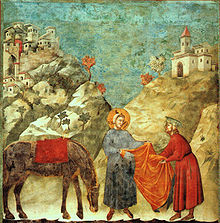Francis of Assisi (Hesse)
Francis of Assisi is a biographical essay on Francis of Assisi by Hermann Hesse . Completed in May 1904, the book was published by Schuster & Loeffler in Berlin in the autumn of the same year.
content
The passage of man from the world and time into eternity is the great theme that Hesse addresses in his brief biography of St. Franz. What luggage should you start your journey with? With none at all, replies St. Francis to his brother Leo. Only those who “keep” the vow of poverty, preaches Franz, will “get over”. In the “begging garment” man should atone for his sin and his lack of understanding. At the beginning of the 13th century and today, such action was and is decried as foolishness. But Franz had heard the "voice of God" and from then on no longer wanted to praise, waste and be haughty. Disinherited and rejected by his biological father, Franz wandered through his Umbrian homeland, taking care of the lepers and the “very poorest” “undaunted” in “happy cheerfulness ”. When Franz begs money for repair work on the St. Damian chapel in his native Assisi , he meets his old drinking brothers. The saint overcomes his shame and also successfully asks the drinker for a gift. After St. Damian has been restored, Franz takes on the Portiuncula chapel, which is also in need of renovation . This “little church” becomes Franz's refuge for life. He always draws back there for contemplation. He lets his faithful take him there shortly before he dies.
Franz remains “a blessed and chosen one”. When he is asked by his companion and brother Masseo von Marignano why he has so much popularity among the people, the saint replies that God has chosen the weakest as his preacher, so that no creature would want to exaggerate the Creator. Two nobles, Mr. Bernhard von Quintavalle and the lady Klara Sciffi , follow St. Francis: Both renounce their property and join the saint.
Hesse calls St. Francis a "real poet", although only the sun song of the Umbrian has come down to us. Hesse justifies his assertion “to the resolution”: In the succession of St. Francis his voice found its echo in the paintings of Giotto in the church in Assisi . Successors of St. Francis, the "favorite of all artists", are, according to Hesse, Thomas von Celano (the creator of the hymn Dies irae ), Giacomo von Verona and Jacopone dei Benedetti . Because, Hesse concludes, the thought of St. Francis alone works miracles, encourages and releases energy to create “a thousand delicious works”. According to Hesse, one of the secrets of St. Franz is: Strength can be drawn from contemplating the miracles in God's free nature.
Self-testimony
Hesse writes about St. Franz, "in order to make a witness from ancient times who have long since fallen silent again speak".
Book editions
The first edition appeared as volume 13 of the series "Die Dichtung", ed. v. Paul Remer. Two further essays by Hesse were added to the 1988 edition: The flower wreath of St. Francis of Assisi and The play of flowers: From the childhood of St. Francis of Assisi .
- Francis of Assisi. Schuster & Loeffler, Berlin 1904.
- Francis of Assisi . With frescoes by Giotto and an essay by Fritz Wagner. Insel, Frankfurt am Main 1988, ISBN 3-458-32769-X (it 1069).
Individual evidence
- ↑ Volker Michels (ed.): Hermann Hesse: Complete works in 20 volumes. Volume 1: Youth Writings. Suhrkamp, Frankfurt am Main 2001, ISBN 3-518-41101-2 , p. 678 and p. 690.
- ↑ Michels, p. 678: From a letter from Hesse dated May 12, 1904 to Paul Remer

